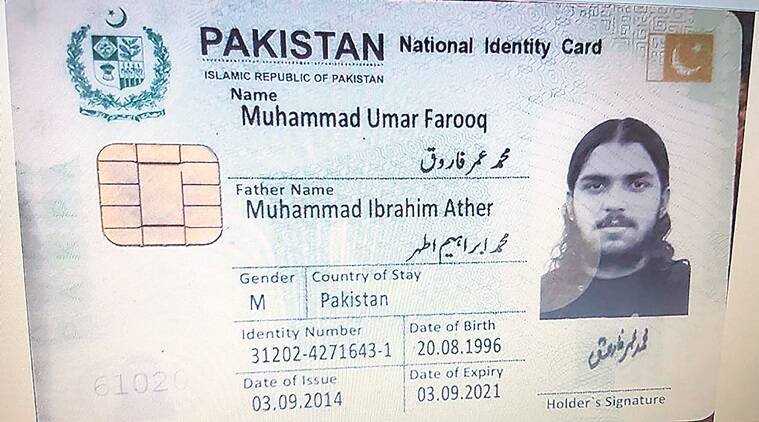
A Pakistan government identity card issued to Mohammed Umer Farooq, key conspirator behind the Pulwama attack.
Terror chats before, after Pulwama: Money in Pakistan bank accounts, IAF movement
The 13,500-page chargesheet, filed Tuesday by the National Investigation Agency (NIA), has transcripts and details of these chats to build its case against terror outfit Jaish-e-Mohammed and its bosses in Pakistan.

In the run-up to the February 14, 2019 terror attack in Pulwama and its aftermath, nearly 350 voice packets (voice messages), running into hours, were exchanged between the terrorists and their handlers in Pakistan. They shared instructions and information, ranging from finances for the attack to movement of fighter aircraft after the Balakot air strike to the use of a Pulwama attack video for propaganda.
The 13,500-page chargesheet, filed Tuesday by the National Investigation Agency (NIA), has transcripts and details of these chats to build its case against terror outfit Jaish-e-Mohammed and its bosses in Pakistan.
In one of these chats, Mohammed Umer Farooq, nephew of Jaish chief Maulana Masood Azhar, asks Rouf Asgar and Ammar Alvi, brothers of Azhar, for money to be deposited in a bank account in Pakistan to finance the attack.
Rs 10 lakh is deposited in two accounts in the name of Umer Farooq in Allied Bank and Meezan Bank of Pakistan, according to the chargesheet. This money, the NIA says, is later brought to Kashmir through illegal financial networks to fund the Pulwama attack.
Another chat shows that from this fund, Rs 5.7 lakh is spent on preparing two IEDs, later fitted in a Maruti Eeco vehicle. Pulwama resident Adil Ahmed Dar drives this vehicle and explodes it near a CRPF convoy on the Jammu-Srinagar highway on February 14, 2019, killing 40 CRPF personnel.
The chat reveals a discussion on the cost of each component of the IEDs and the money spent in executing the attack. The chat, in Urdu, pegs the cost of at IED at Rs “570000”.
In another voice packet, Rouf Asgar is heard asking Umer Farooq about the movement of Indian fighter aircraft in Kashmir following the Balakot air strikes – on February 26, 2019, India targeted a Jaish base in Balakot, deep inside Pakistan.
The Jaish, the chargesheet says, also planned to use the Pulwama attack for propaganda. In a voice packet exchange, Rouf Asghar and Umar Farooq discuss a video showing bodies of Indian security men, and how it should be used to influence Kashmiri youth.
“They also wanted to make an audio-video on Adil Dar in Kashmiri, eulogising him as a shaheed to inspire Kashmiri youth. This plan was shelved due to the Balakot strikes because they were told to lie low,” an NIA officer said.
The NIA has already matched the voice of Asgar from these chats with that of his voice samples available via open source.
Umer Farooq, son of IC-814 hijacker Ibrahim Athar, was killed in an encounter a month after the Pulwama attack. The J&K police recovered a Samsung S9 mobile phone from the site. Though the phone was damaged in the exchange of fire, forensic experts managed to retrieve data after the case was handed over to the NIA.
According to the NIA chargesheet, Umer, who had infiltrated into India in April 2018, had brought around 12 kg of RDX with him.
Along with the RDX brought on previous trips, the terrorists packed 35 kg of RDX with ammonium nitrate, gelatine sticks and aluminium powder into two IEDs, weighing 160 kg and 40 kg, respectively.
NIA sources said the voice packets exchanged between the terrorists and their Jaish handlers in Pakistan are largely from the period preceding the attack.
“Umer Farooq’s Samsung phone had details of the entire planning in the form of chats, voice packets and pictures. When the Forensic Science Laboratory gave us the data, it took us 14 hours just to listen and analyse the voice packets. Since all had been deleted after the attack, the retrieved data came in chronological order. It took a massive amount of effort to sift through it, pick relevant data and match instructions with action and replies,” an NIA officer said.
Some voice packets of the initial few months when Umer Farooq infiltrated into Kashmir were lost, but all the photographs were retrieved.
“After a few months in Kashmir, the attackers bought new phones, discarding the old ones. Farooq had done a back-up of all pictures, but not of the voice packets. So we have voice packets only from the few months preceding the attack. But they conclusively prove Jaish’s role in the attack,” the NIA officer said.
Sources in the Ministry of Home Affairs said the evidence that the NIA has gathered against Masood Azhar, Jaish and how the entire attack was directed from Pakistani soil, will help India mount pressure on Pakistan in international fora including the Financial Action Task Force where it is trying to avoid blacklisting.
